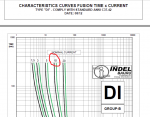Have to agree w/ Augie (and Don). Last year when I watched my Poco (BGE) replace my failed 25 kVA transformer, I saw them replace the cutout with this 10DI fuse...
View attachment 2556866
Looking up the data on that fuse shows it would pass 20A for 5 minutes before opening. Looks like it would let thru 10 or 15A forever.
View attachment 2556865
This is a 7680 Primary, that's a 32:1 ratio on the windings, so it could supply something like 300 to 600 amps on the secondary without clearing a "fault". Way enough time (and heat) to burn thru an overhead or underground secondary conductor that was arcing.
They clearly are trying to minimize nuisance tripping and protect against only the most severe overloads.
Want that fuse to open in 1 sec? It's going to take at least 100A. On the primary.



